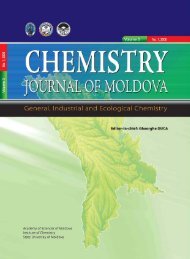stiinte med 1 2012.indd - Academia de ÅtiinÅ£e a Moldovei
stiinte med 1 2012.indd - Academia de ÅtiinÅ£e a Moldovei
stiinte med 1 2012.indd - Academia de ÅtiinÅ£e a Moldovei
You also want an ePaper? Increase the reach of your titles
YUMPU automatically turns print PDFs into web optimized ePapers that Google loves.
248<br />
processes and prevention of installation of multiple<br />
organ injuries improving wound healing.<br />
The revealed postoperative results confirm the<br />
efficacy of diagnostically techniques and <strong>med</strong>icosurgical<br />
attitu<strong>de</strong> which <strong>de</strong>monstrated good results in<br />
all100 % of the cases.<br />
References<br />
1. Lebrec D., Hemodynamic effects of endotoxin<br />
and platelet activating factor in cirrhotic rats.<br />
Gastroenterology, 1992; 103:282-288.<br />
2. Van Deventer S.J.H., Ten Cate J.W., Tytgat<br />
G.N.J., Intestinal endotoxemia: clinical signifi cance.<br />
Gastroenterology, 1988; 94: 825-831.<br />
3. Ni R.Y., Hepatogastrointestinal dysfunction. Ni<br />
R.Y., Advanced doctor training course for infectious<br />
diseases. Wuhan:Wuhan University Press, 1996:33-34.<br />
4. Kaufhold A., Behrendt W., Krauss T., Van Saene<br />
H., Selective <strong>de</strong>contamination of the digestive tract and<br />
methicillin-resistant staphylococcus aureus. Lancet, 1992;<br />
339:1411-1412.<br />
5. Blaise M., Pateron D., Trinchet J.C., Levacher S.,<br />
Beaugrand M., Pourriat J.L., Systemic antibiotic therapy<br />
prevents bacterial infection in cirrhotic patients with<br />
gastrointestinal hemorrhage. Hepatology, 1994; 20:34-38.<br />
6. Deitch E.A., Maejima K., Berg R., Effect of oral<br />
antibiotics and bacterial overgrowth on the translocation<br />
of the GI tract microfl ora in burned rats. J Trauma, 1985;<br />
25:385-392.<br />
7. Multiple-organ failure: generalized auto<strong>de</strong>structive<br />
infl ammation? Arch. Surg., 1985; 120:1109-1115.<br />
8. Marshall J.C., Sweeney D., Microbial infection and<br />
the septic response in critical illness. Arch. Surg., 1990;<br />
125:17-23.<br />
9. Bone R.G., Sepsis. SIRS and MODS: the new<br />
<strong>de</strong>fi nition. Proceedings of Sepsis/SIRS. Washington, DC,<br />
February 21-22, 1995.<br />
10. Bohnen J.M.A., Solomkin J.S., Dellinger E.P., et<br />
al. Gui<strong>de</strong>lines for clinical care: anti-infective agents for<br />
intra-abdominal infection: Surgical Infection Society<br />
policy statement. Arch. Surg., 1992; 127:83-89.<br />
11. Wittmann D.H., Symposium of intra-abdominal<br />
infections: introduction. World J. Surg., 1990; 14:145-<br />
230.<br />
12. Wittmann D.H., Walker A.P., Condon R.E.,<br />
Peritonitis, intra-abdominal infection, and intra-abdominal<br />
abscess. Schwartz S.I., Shires G.T., Spencer F.C., eds.<br />
Principles of Surgery. 6th ed. New York: McGraw Hill:<br />
1993:1449-1484.<br />
13. Rotstein O.D., Meakins J.L., Diagnostic and<br />
therapeutic challenges of intra-abdominal infections.<br />
World J. Surg., 1990; 14:159-166.<br />
Rezumat<br />
Articolul prezintă o analiză a rezultatelor obţinute în<br />
tratamentul peritonitei apendiculare acute generalizate,<br />
utilizând tehnici <strong>de</strong> diagnostic special selectate şi tratament<br />
<strong>med</strong>ico-chirurgical.<br />
Buletinul AŞM<br />
Analizând literatura <strong>de</strong> specialitate şi reieşind din<br />
studiile personale, se poate concluziona că tratamentul<br />
chirurgical individualizat este doar o etapă în procesul<br />
terapeutic şi este necesar <strong>de</strong> a reechilibra o multitudine<br />
<strong>de</strong> tulburări biochimice, metabolice, acido-bazice,<br />
consi<strong>de</strong>rate ca fiind şi potenţiali factori <strong>de</strong> risc în instalarea<br />
complicaţiilor septico-purulente, abcese, ocluzii intestinale<br />
la copil.<br />
Summary<br />
The present article present an analysis of the results<br />
in treatment of appendicular acute generalized peritonitis,<br />
using special selected diagnostically methods and <strong>med</strong>icosurgical<br />
treatment.<br />
It can be consi<strong>de</strong>red, analyzing literature of specialty,<br />
that the individualized treatment it is only one step in<br />
therapeutically arsenal and it is necessary to reechilibrate<br />
a multitu<strong>de</strong> of biochemical, metabolic, acido-basic<br />
disturbances consi<strong>de</strong>ring being potential factor of risk in<br />
installation of septico-purulent complications.<br />
Резюме<br />
Статья представляет анализ результатов лечения<br />
острого разлитого перитонита у детей аппендикулярного<br />
генеза с применением специальных методов диагностики<br />
и лечения.<br />
Анализируя литературные данные и собственные<br />
наблюдения на 320 детей, оперированныx в нашей клинике,<br />
можно сделать вывод, что хирургическое лечение<br />
– это только один этап в лечении разлитого перитонита<br />
у детей. Кроме этого, необходимо устранить биохимические,<br />
метаболические и кислотно-щелочные нарушения,<br />
которые являются факторами риска в развитии<br />
таких гнойно-септических осложнений, как абсцессы<br />
брюшной полости, кишечная непроходимость, сепсис<br />
и синдром полиорганной недостаточности.<br />
CONGENITAL LOBAR EMPHYSEMA<br />
IN CHILDREN<br />
_______________________________________<br />
Eva Gudumac, Aca<strong>de</strong>mician SAM, PhD in<br />
<strong>med</strong>icine, univ. professor, Professor emerita,<br />
Alina Danila, doctoral candidate, NSPCPS<br />
„Aca<strong>de</strong>mician Natalia Gheorghiu”<br />
Introduction<br />
Congenital localized emphysema (lobar<br />
emphysema, obstructive emphysema, hypertrophic<br />
emphysema, polialveolar lobe) represents a congenital<br />
terminal (distal) bronchopulmonary malformation<br />
and is <strong>de</strong>fined as a progressive diffuse, abnormal<br />
and uniform hyperinflation of the pulmonary alveoli,<br />
of one or two lobes, usually of the upper one, with<br />
the subsequent formation of one or more bubbles<br />
un<strong>de</strong>r pressure, without a wall of their own, with the

















